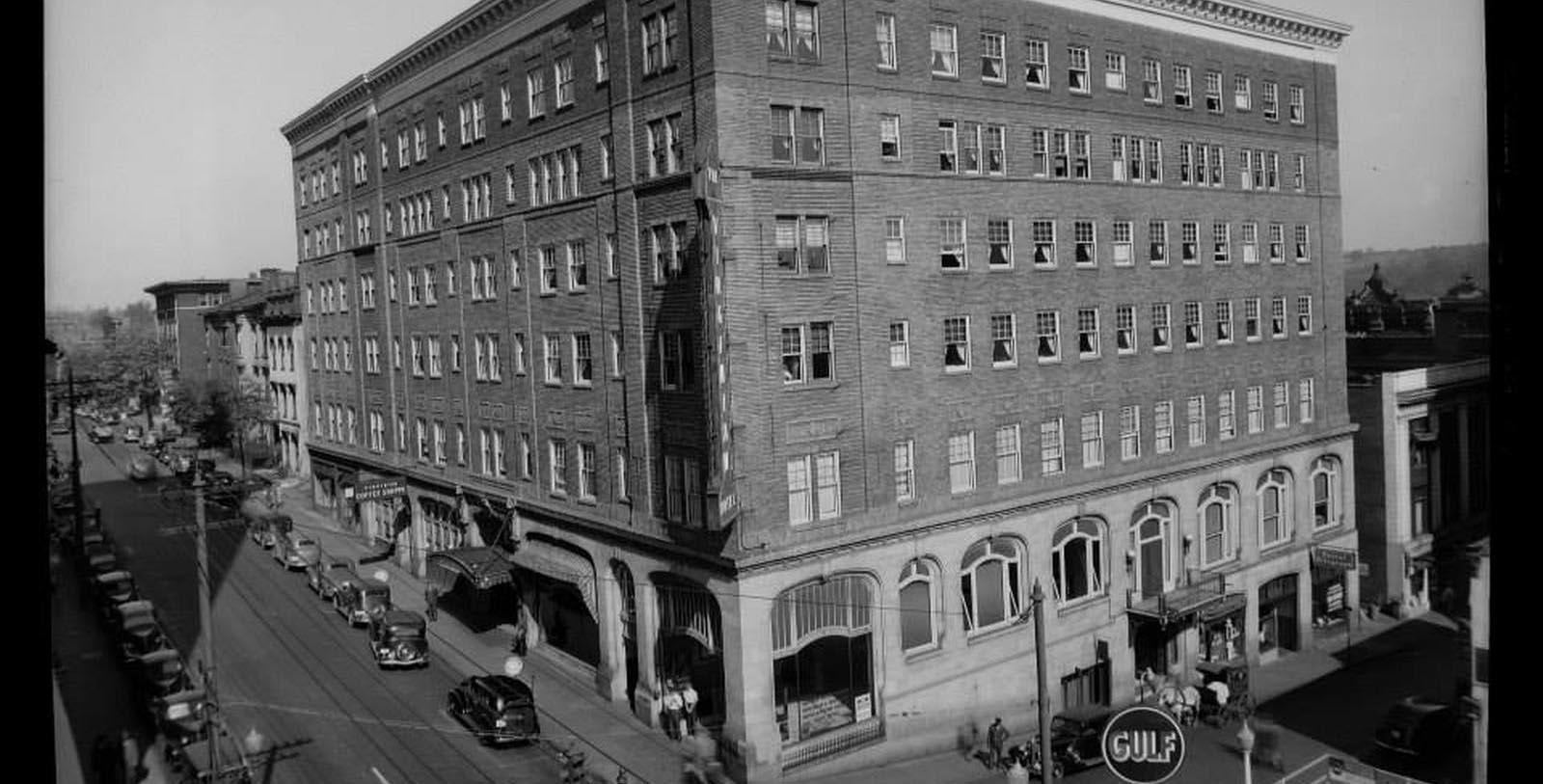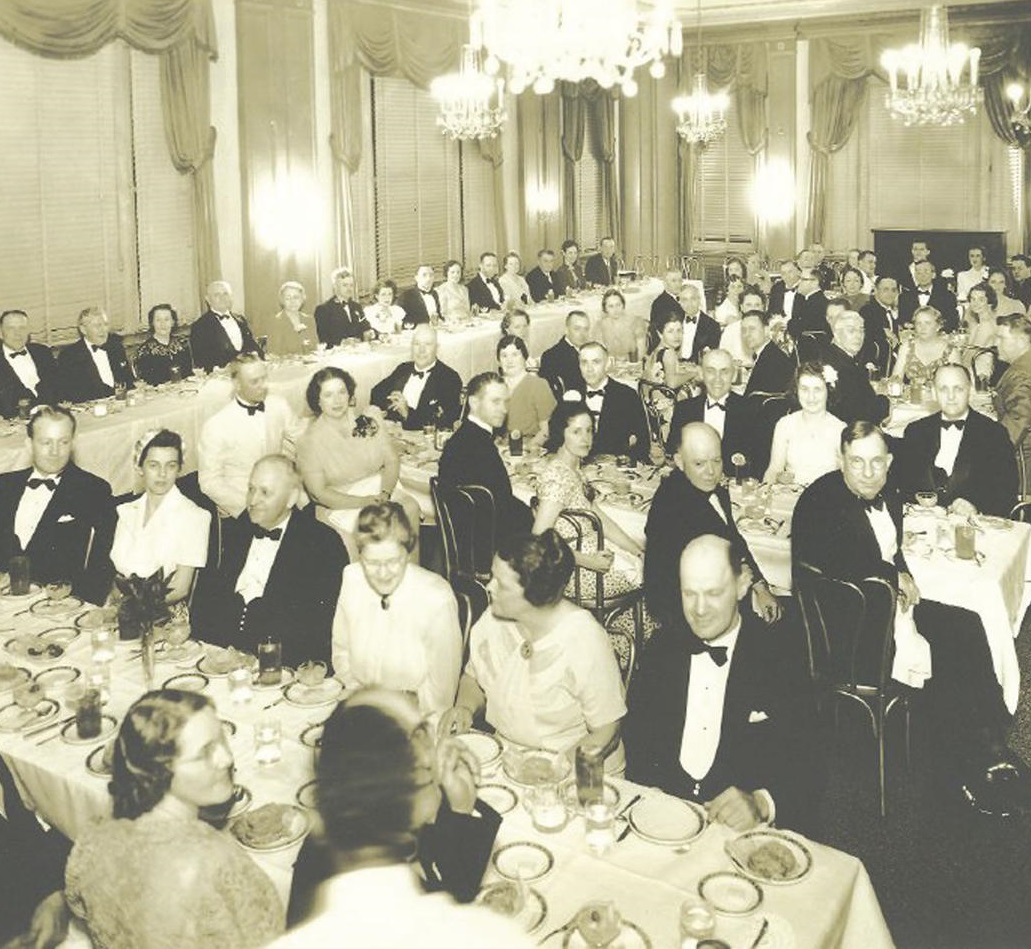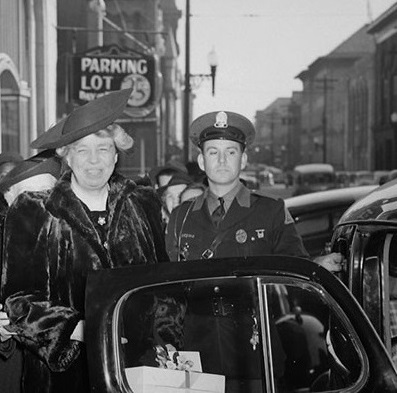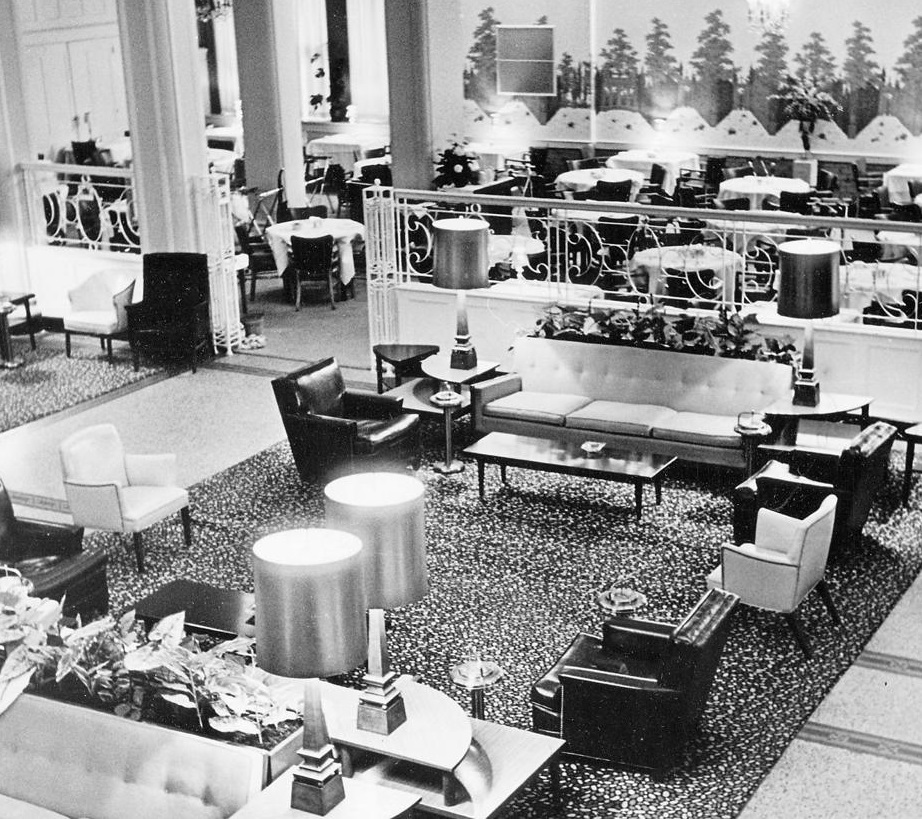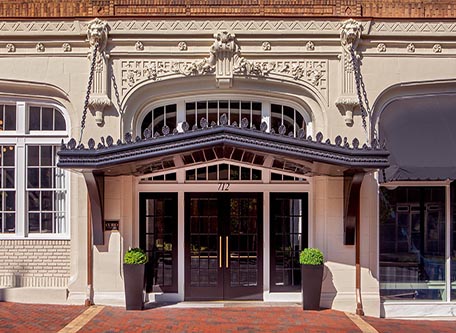Receive for Free - Discover & Explore eNewsletter monthly with advance notice of special offers, packages, and insider savings from 10% - 30% off Best Available Rates at selected hotels.
history
Discover the Virginian Lynchburg, Curion Collection by Hilton, the five-story Classical Revival hotel, which was originally designed by esteemed architect Verus T. Ritter.
The Virginian Lynchburg, Curio Collection by Hilton, a member of Historic Hotels of America since 2018, dates back to 1913.
VIEW TIMELINEA member of Historic Hotels of America since 2018, The Virginian Lynchburg, Curio Collection by Hilton, has been an iconic fixture in downtown Lynchburg for more than a century. Constructed in the early 1900s as the “Virginian Hotel,” the building has hosted thousands of guests over the years due to its reputation for unrivaled service and overwhelming elegance. It owes its beautiful appearance to Verus T. Ritter, a prominent architect who had designed dozens of structures throughout Philadelphia as partner in the architectural firm, “Ritter & Shay.” (Among the buildings that Ritter developed in Pennsylvania included the renowned Packard Building, the U.S. Custom House, and the Market Street National Bank.) At the behest of the Lynchburg Hotel Company, Ritter raised a towering five-story-tall skyscraper at the corner of Church and Eight streets, which displayed some of the finest Classic Revival-style architecture in the whole commonwealth. But the architect also relied upon some aspects of the Beaux-Arts for the building’s interior, constructing such architectural elements like grand marble staircase, stunning arched windows, and an ornate lobby that had a 30-foot barrel vaulted ceiling with curved skylights. Many distinctive colonnades proliferated throughout the ground level, too, featuring carvings of crested capitals that bore the letter “V.” Perhaps the most iconic feature of the newly constructed hotel was its illuminated rooftop and corner-blade signage that loomed over the local skyline.
Debuting before hundreds of people in 1913, the Virginian Hotel quickly ingrained itself into the cultural fabric of Lynchburg. Many celebrated Ritter’s work, including several regional newspapers that hailed the structure as an engineering masterpiece. The magnificent edifice soon emerged as one of the main social gathering spots in the city, becoming an exclusive venue for grand parties and soirees. But throngs of guests from across the nation also began to arrive, prompting its managerial team to commission the development of another floor in 1927. (Architect Stanhope S. Johnston oversaw that project, in addition to another extension that opened some six years later.) By the middle of the century, the Virginian Hotel had even attracted some of the most prominent luminaries in the country, including former First Lady Eleanor Roosevelt and future U.S. President Ronald Reagan. All the while, the Lynchburg Hotel Company—still owners of the business—continued renovating the building to address its surging popularity. The culmination of its work was a massive construction project that added a wonderful terrace dining room into the lobby.
Yet, the Hotel Virginian fell on hard times as Lynchburg’s economy receded into a prolonged depression during the 1960s. The Lynchburg Hotel Company eventually sold the business to an out-of-town firm, which in turn auctioned it off to Malcolm E. Wilder of Band Box Inc. Wilder subsequently renovated the building into the “Stewart Arms Hotel,” transitioning away from its previous identity. Nevertheless, Wilder’s endeavor failed and the Stewart Arms Hotel became a part of the newly created Liberty University (originally called “Liberty Baptist College”). The building specifically served as one of the school’s first dormitories for quite a while. Then after spending the better part of three decades as a housing complex, the erstwhile hotel was put up for sale yet again. This time, real estate developers George Stanley and Blair Godsey purchased the structure with the intent on converting it into a luxury apartment building. But upon reviewing the location’s beautiful historical architecture, they decided to reconfigure it back into a boutique hotel. Striking a deal with Hilton Worldwide to operate the building within its prestigious Curio Collection, Stanley and Godsey began restoring the hotel back to its former glory in 2015. When the work finally concluded some two years later, the City of Lynchburg celebrated its return with great acclaim. Now operating as “The Virginian Lynchburg, Curio Collection by Hilton,” the hotel is once more one of Virginia’s most celebrated holiday destinations.
-
About the Location +
In 1757, a 17-year-old boy named John Lynch established a ferry service on property owned by his father, Charles, along the James River. Many people in the surrounding area at the time had found it increasingly difficult to export their agricultural products to market. As such, John Lynch decided to remedy the situation by transporting goods upstream on their behalf. The business proved to be incredibly successful, with merchants setting up small shops next to Lynch’s wharf. Over time, the storefronts and cottages coalesced into a prosperous country village. Among the first arrivals to the new settlement were Quakers, attracted to the region by the South River Society of Friends’ meeting house. The Quakers would remain a fixture in the community for the until the dawn of the next century, occupying three different meeting houses within that span of time. Lynch’s river crossing had steadily evolved into an important center of trade by the time of the American Revolution, prompting the riverboat captain to petition the Virginia General Assembly to grant the village a charter. The commonwealth government eventually accepted the request, designating the settlement of “Lynchburg” a formal town in 1786. Lynchburg remained small during the first few years of its existence, as only a handful of residences, taverns, and shops opened downtown. But warehouses began to appear as well, driven by the growth of the local tobacco industry out in the countryside. Planters recognized the value of Lynchburg’s proximity to the James River and used the community as the primary point of departure for their cargo. The town’s prominence as a transportation hub soon attracted entrepreneurial businesspeople in other trades, who subsequently built groceries, tanneries, and blacksmiths.
In 1806, Lynchburg saw one of America’s most famous citizens become a member of its community—U.S. President Thomas Jefferson. Desiring a place to escape from his home of Monticello, Jefferson spent several years building a magnificent estate that he called “Poplar Forest” just to the west of town. He subsequently entertained many guests at Poplar Forest, visiting more frequently as he grew older in age. Tobacco continued to dominate the local economy, inspiring Lynchburg’s residents to discover novel ways in which to ship the crop for sale. Town officials began sponsoring projects that would link Lynchburg to the Kanawha Canal, and later the Lynchburg and Tennessee Railroad. Telegraph lines also arrived from Richmond, allowing for traders and tradesmen to speak with one another at an unprecedented rate. Yet, the city’s prosperity came to an abrupt end when the American Civil War erupted in the 1860s. Lynchburg’s citizenry largely supported the Confederacy, using their homes, churches, and municipal buildings to act as makeshift hospitals and supply depots. Fortunately for the locals, Lynchburg was spared much of the devastation experienced elsewhere in Virginia. Still, Union and Confederate forces did confront one another in the hills beyond town. Union General David Hunter attempted to capture Lynchburg in June of 1864, only to be driven through a combination of deception and rapid strikes by the rebel army of Jubal Early. While Lynchburg would remain in Confederate hands for the rest of the war, it ultimately capitulated once Robert E. Lee surrendered the following year. (Lynchburg also briefly served as the capital of the Confederacy once Richmond fell in early April of 1865.)
Lynchburg and its environs gradually abandoned the tobacco trade in the aftermath of the American Civil War, replacing it instead with heavy industry. New businesses—such as blast furnaces, iron works, and steel mills—debuted all across the town in a matter of years. Some of largest corporations in Virginia were among those operating in Lynchburg, including the Craddock-Terry Shoe Company, the Lynchburg Lough Company, and the Glamorgan Pipe & Foundry. Spurring this development was the arrival of additional railways, specifically the Richmond and Allegheny Railroad. Thousands of people soon emigrated into Lynchburg as such, transforming the town into a modern city at the start of the 20th century. A real estate boon spread throughout the community, too, giving rise to many beautiful neighborhoods. Some of the community’s most recognizable landmarks also appeared, like the Academy of Music and the Jones Memorial Library. A couple of renowned schools even opened as well, like Randolph College and Lynchburg University (Liberty University would not appear in the city until the 1970s.) Nevertheless, Lynchburg’s new economy managed to endure the Great Depression, as well as both world wars (which the city enthusiastically supported.) Today, Lynchburg is among the most dynamic cities in the entire commonwealth. It is home to several fascinating cultural attractions, including the Mill Mountain Zoon, the Legacy Museum, and Point of Honor. Lynchburg is also just a couple hours away from such places like Shenandoah National Park, Thomas Jefferson’s Monticello, and James Madison’s Montpelier.
-
About the Architecture +
The Virginian Lynchburg, Curio Collection by Hilton, features a wonderful blend of Classical Revival-style architecture. Also known as “Neoclassical,” Classic Revival design aesthetics are among the most common architectural forms seen throughout the United States. This wonderful architectural style first became popularized at the World’s Columbian Exposition, which was held in Chicago in 1893. Many of the exhibits displayed architectural motifs from ancient societies like Rome and Greece. As with the equally popular Colonial Revival style of the same period, Classical Revival architect found an audience for its more formal nature. It specifically relied on stylistic design elements that incorporated such structural components like the symmetrical placement of doors and windows, as well as a front porch crowned with a classical pediment. Architects would also install a rounded front portico that possessed a balustraded flat roof. Pilasters and other sculptured ornamentations proliferated throughout the façade of the building, as well. Perhaps the most striking feature of buildings designed with Classical Revival-style architecture were massive columns that displayed some combination of Corinthian, Doric, or Ionic capitals. With its Greco-Roman temple-like form, Classical Revival-style architecture was considered most appropriate for municipal buildings like courthouses, libraries, and schools. Yet, the form found its way into more commercial uses over time, such as banks, department stores, and of course, hotels. The celebrated architectural firm McKim, Meade and White produced some of the most noteworthy buildings that utilized Classical Revival architecture, with most of their work appearing during the early 20th century. Examples of their portfolio can be found throughout many of American’s major cities, including Philadelphia and New York City. They were later joined by many other prominent architects, including the creator of The Virginian Lynchburg, Curio Collection by Hilton—Verus T. Ritter.
Yet, The Virginian Lynchburg, Curio Collection by Hilton, also showcases elements of Beaux-Arts architecture within some of its interior spaces. Among the most notable Beaux-Arts-inspired features included a grand marble staircase, distinctive colonnades, and an ornate lobby that featured a 30-foot barrel vaulted ceiling with curved skylights. (Other impressive architectural elements included the arched windows throughout the first floor, as well as carvings of crested capitals that bore the letter “V.”) Beaux-Arts-style architecture itself became widely popular around the dawn of the 20th century. This beautiful architectural form originally began at an art school in Paris known as the École des Beaux-Arts during the 1830s. There was much resistance to the Neoclassism of the day among French artists, who yearned for the intellectual freedom to pursue less rigid design aesthetics. Four instructors in particular were responsible for establishing the movement: Joseph-Louis Duc, Félix Duban, Henri Labrouste, and Léon Vaudoyer. The training that these instructors created involved fusing architectural elements from several earlier styles, including Imperial Roman, Italian Renaissance, ad Baroque. As such, a typical building created with Beaux-Arts-inspired designs would feature a rusticated first story, followed by several more simplistic ones. A flat roof would then top the structure. Symmetry became the defining character, with every building’s layout featuring such elements like balustrades, pilasters, and cartouches. Sculptures and other carvings were commonplace throughout the design, too. Beaux-Arts only found a receptive audience in France and the United States though, as most other Western architects at the time gravitated toward British design principles.
-
Famous Historic Guests +
Eleanor Roosevelt, First Lady to former U.S. President Franklin Delano Roosevelt (1933 – 1945)
Ronald Reagan, 40th President of the United States (1981 – 1989)
-
Women in History +
Eleanor Roosevelt: Among the many guests to stay at The Virginian Lynchburg, Curio Collection by Hilton, over the years was former First Lady Eleanor Roosevelt. She was born Anna Eleanor Roosevelt in 1884, the daughter of Elliott and Anna Hall Roosevelt. A member of the Oyster Bay clan of the Roosevelt dynasty, Elliott himself was the brother of U.S. President Theodore Roosevelt. Roosevelt’s immediate family cherished community service, although both her parents died at an early age. Her intellectually progressive outlook on life was further reinforced by Marie Souvestre, who was Roosevelt’s headmistress during her time in London’s prestigious Allenswood Boarding Academy. Nevertheless, she kept those personal influences close to her heart, and used them as the foundation for her future work as a social activist. Indeed, some of her earliest work involved tending to the overcrowded settlement houses in New York City’s Lower East Side.
Around the same time, she began courting her distant cousin, Franklin Delano Roosevelt. They eventually married in 1905 and had six children together. Yet, the marriage was strained by the two’s dueling personalities, as well as the demands of her husband’s early political career. Roosevelt often felt her responsibilities as a “political wife” were tedious, especially after Franklin’s appointment as the Assistant Secretary of War shortly before the outbreak of World War I. Their marriage further deteriorated in 1918, when Eleanor discovered that Franklin had an affair with their mutual friend, Lucy Mercer. Roosevelt, thus, vowed to throw herself fully back into her political activism. But the two had a strong understanding that their fates remained intertwined and aspired to support one another going forward. It was Eleanor who encouraged Franklin to remain in politics even after he was beset with polio in 1921. As such, Eleanor Roosevelt was incredibly instrumental in aiding her husband’s election as the Governor of New York in 1928, as well as his subsequent rise to the presidency four years later. She often gave numerous speeches in public on his behalf that galvanized thousands of people. Roosevelt also became a central figure at of his many campaign events, serving as her husband’s voice whenever he could not attend.
But Eleanor Roosevelt still established her own vibrant political career as the First Lady of the United States. Historians today consider her actions to have fundamentally transformed the role that the First Lady traditionally held within the national government. Roosevelt used her position to advance a number of causes close to her heart, including gender equality, civil rights, and housing reform. For instance, she arranged a massive celebration at the nearby Lincoln Memorial to protest the racist decision of the Daughters of the American Revolution to not let Marian Anderson—an African American opera singer—perform at Constitution Hall. On another occasion, she privately lobbied for the passage of the Costigan-Wagner Bill, which would have made lynching a federal crime. Roosevelt also held exclusive press conferences at the White House for female journalists, in order to help enable women to break into the field. She even attempted to create an experimental community in West Virginia called “Arthurdale,” where homeless miners unfairly driven out of the industry would have a shot at achieving a new, independent life. Although considered a failure, it was testimony to her commitment to enhance the lives of countless others.
Eleanor Roosevelt’s historic career continued well after her time as the nation’s First Lady ended in 1945. She played a significant role in transforming Hyde Park into a museum dedicated to her late husband’s legacy, which set the precedent for future presidential libraries to follow. She also served as a delegate to the United Nations Commission on Human Rights, becoming its chairperson in 1947. Roosevelt remained with the organization until 1953, and her political insight proved integral toward drafting the Universal Declaration of Human Rights. After working to reform New York politics throughout the remainder of the decade, Roosevelt eventually worked to support the campaign of John F. Kennedy. While she initially rebuffed Kennedy for his refusal to denounce McCarthyism, Roosevelt relented on the grounds that she believed he had the best chance of leading the nation into the future at the time. When Kennedy won in 1960, she became his representative to such organizations like the National Advisory Committee to the Peace Corps. Then, in 1961, Kennedy appointed her as the First Chair of the Presidential Commission on the Status of Women. But Roosevelt would not see the commission come to fruition, as she died mere months after it was organized. Eleanor Roosevelt has since been revered as one of the most influential figures in 20th-century American history and is esteemed throughout the world today for her years of advocacy.
























